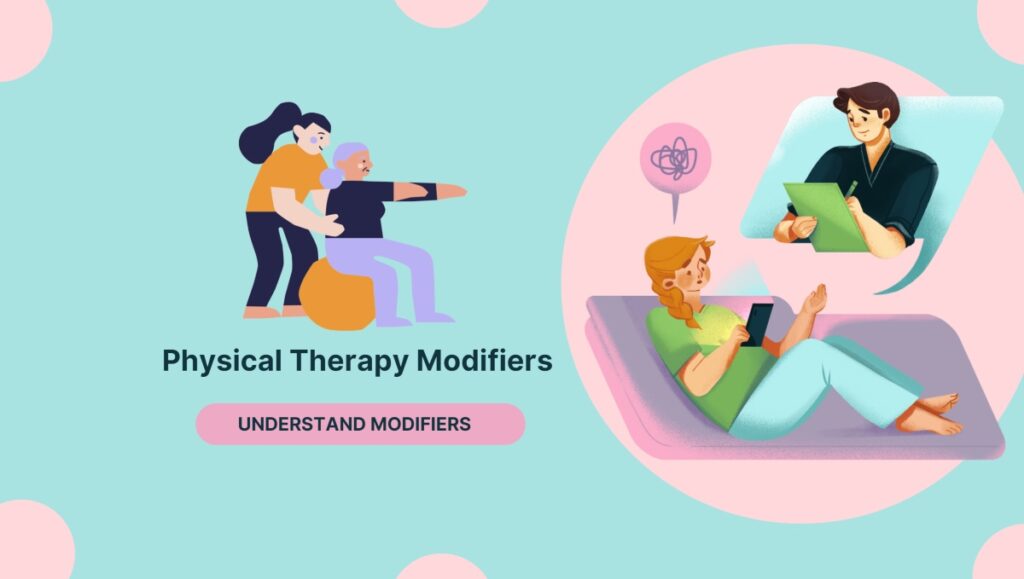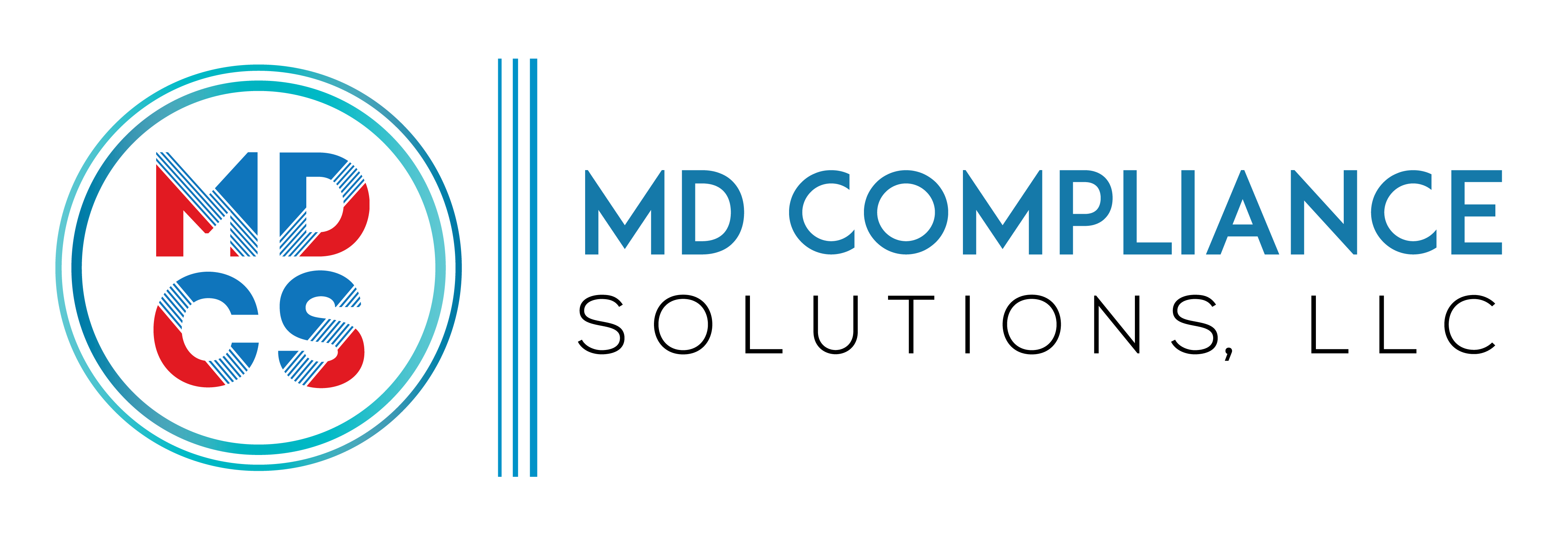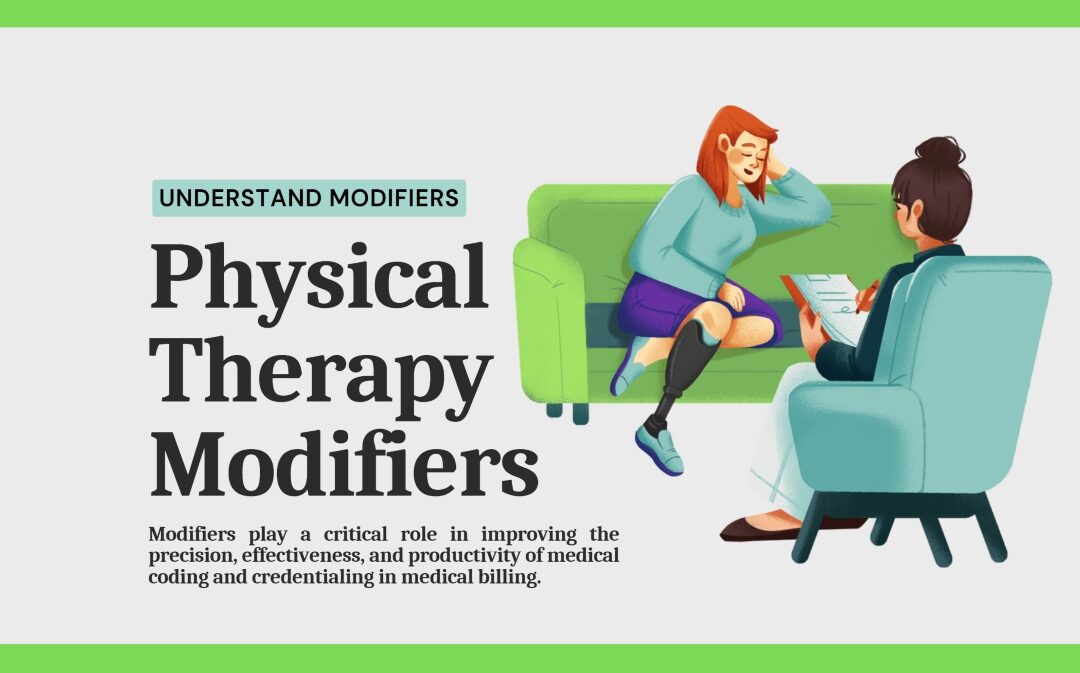Table of Contents
Among the most fulfilling career is physical therapy. However, it is also certain that physical therapists are aware of the complexity of therapeutic approaches. These healthcare professionals invest a so much time and effort in making sure their patients heal as fully as possible. This practice may extant even greater challenges than others when it comes to medical billing and physical therapy modifiers.
Modifiers play a critical role in improving the precision, effectiveness, and productivity of medical coding and credentialing in medical billing. Modifiers support in the understanding of the specifics of the services rendered in physical therapy, which enhances the medical billing and coding procedure. By using these modifiers, you may make sure that physical therapy treatments are accurately billed and reimbursed. You will understand about the various physical therapy modifiers in this post.
Understand Modifiers:
Primarily, what exactly are modifiers? Modifiers are characters that add extra information about a medical treatment, service, or supply to CPT or HCPCS Level II codes. Without altering the code’s meaning, they provide specifics about the encounter. In order to indicate that a service was rendered differently, physical therapists can apply modifications to the medical codes for various diseases. Further information that is not clear from the code descriptor is provided by modifiers. It is crucial to refer to the payer’s rules to make sure that every physical therapy service is coded with the appropriate modifier.
There may be modifiers for some payer programs that only come into play when you report codes related to such programs. To ensure they get paid correctly, they assist providers in documenting the method modification. By increasing claim precision, modifiers contribute to better medical billing. In addition to avoiding denials, this expedites the processing of claims. Knowing the different kinds of modifiers and knowing how to use them correctly are crucial for accurate medical billing. Payout delays, income loss, or claim rejection are all possible outcomes of using the incorrect modifier.
Physical Therapy Modifiers Types
CPT Modifiers:
Typically utilized for billing Medicare and commercial insurers, CPT modifiers are two-digit codes. American Medical Association (AMA) is the owner of its copyright. It is noteworthy that the modifiers utilized in conjunction with physical therapy codes may differ according on the payer and the nature of the service being recorded. The following CPT modifiers are frequently used in medical billing: physical therapy modifiers.
Modifier 59
Modifier 59 distinguishes between two services that are similar and are given in the same therapy session. Modifier 59 aids in demonstrating to the insurance provider that every treatment or service rendered during the session was required and carried out independently of any other non-evaluation or management service that day. You can demonstrate to Medicare that both services’ payments adhere to the National Correct Coding Initiative by doing this. When doing an operation on a distinct and diverse bodily component, this modification is also helpful.
When providing care for a patient and invoicing separately for 15 minutes of manual therapy (97140) and 15 minutes of therapeutic activities (97530), for instance, you can utilize Modifier 59 in this scenario. Even if the two services were rendered on the same day, adding modifier 59 to your CPT code increases the likelihood that you will be paid for them both.
Modifier 76
In medical billing, modifier 76 is used to denote that the same treatment or operation was rendered by the same provider again that day. This modification is frequently applied when an operation needs to be repeated after failing the first time. Healthcare providers can make sure that the repeated operation is correctly invoiced and reimbursed by utilizing Modifier 76.
Modifier 80
When indicating that a related operation or service was completed on the same day as the primary procedure, medical billing modifier 80 is utilized. This modification is frequently applied when treating a related ailment or finishing the primary procedure requires a secondary procedure. Healthcare professionals can make sure that the relevant operation is correctly invoiced and reimbursed by utilizing Modifier 80.
Modifiers for Level II Healthcare Common Procedure Coding System (HCPCS)
The alphanumeric or two-lettered HCPCS Level II modifiers are included in billing for Medicaid, Medicare, and certain commercial plans. The Centers for Medicare & Medicaid Services (CMS) is responsible for their upkeep. These modifiers are frequently used to specify details about the service, like its location, the kind of equipment it uses, and the involvement of additional medical professionals. The following are a few of the most popular Level II HCPCS modifiers:
GP Modifier
The GP Modifier is frequently applied in both outpatient and inpatient contexts. It signifies that a physical therapy care plan was followed in the delivery of a service or treatment. When a line item with the GP modifier is used, it indicates that the service was rendered by a licensed physical therapist. The provider offering services in a multidisciplinary context can also be identified using GP codes. In medical billing, the GP modifier is used to specify that a physician assistant (PA) carried out a service while being closely supervised by a physician.
GP Modifier is frequently applied when a PA is giving regular or maintenance care and the supervising physician is on hand to offer advice or step in if needed. One example of this is the billing of CPT Code 97110 by both physical and occupational therapists. To prevent confusion, the GP code identifies which provider is offering this service.
KX Modifier
When a qualified non-physician practitioner (QNPP) performs a service under a physician’s supervision, they are required to utilize the KX modifier in medical billing. When a nurse practitioner (NP) or physician assistant (PA) performs a service that a doctor would normally bill for, this modifier is frequently utilized. Once the patient has surpassed Medicare’s threshold, the KX Modifier is applied. Stated differently, it certifies that the conditions stipulated in the payer-specific medical insurance have been fulfilled. If a therapist is certain that after reaching the threshold, continued treatment or services are required, it is recommended to utilize this modification. The therapist must demonstrate the necessity of this treatment with appropriate documentation.
A patient who needs one treatment but has reached their threshold for another vital medical procedure can serve as an example of this. Patients may be happier with their care if they have better access to services and lower wait times. QNNPs can increase healthcare practice efficiency by handling basic chores and freeing up clinicians’ time to focus on more difficult situations.
Modifier GT
In medical billing, the modifier GT is used to denote that a certified registered nurse anesthetist (CRNA) conducted the service. Usually, a CRNA will utilize this modification when giving anesthesia during a surgery or other medical procedure. The identity and qualifications of a CRNA who performs anesthetic services are often recorded in the patient’s medical file. For billing and reimbursement purposes, it is possible to specifically identify that a CRNA delivered the anesthetic by using the GT modifier.
GA Modifier
When a medical treatment is not required, the GA Modifier is employed. To let the patient, know that Medicare will not be paying for the medical services they will be receiving, an Advance Beneficiary Notice of Non-coverage (ABN) is filed in this situation. It enables the therapist to bill the patient or another primary care physician in its place. GA modifier is normally applied when the supervising therapist is on hand to offer direction or step in if needed, while the assistant is doing routine or maintenance therapy.
CQ/CO Modifier
The CQ or CO modifier supports in identifying whether the service is provided entirely by occupational therapist assistants (OTA) or by physical therapist assistants (PTA).
CQ Modifier (Physical therapist assistant): A physical therapist assistant’s outpatient physical therapy services are determined, either entirely or in part, by the CQ Modifier. To indicate how the assistant is involved in the treatment, this modifier is supplied in addition to the main therapy code. On the medical claim, the CQ modifier and the relevant therapy code are reported. It contributes to correct invoicing and payment for the assistant’s services.
CO Modifier (Therapy assistant): Another code used in medical billing is the CO Modifier, which denotes situations in which a therapy service was provided by a therapist assistant working under the general supervision of a licensed therapist. When an assistant is conducting routine or maintenance therapy and the supervising therapist is on hand to offer direction or step in if needed, this modifier is frequently utilized. It contributes to correct invoicing and payment for the assistant’s services.
Wrap Up:
It might be difficult to manage medical billing when there are so many modifiers and codes. Understanding the particular setting of physical therapy modifiers will enable you to file claims more quickly and cleanly, and optimizing compensation.
Read More: Modifiers for Unsuccessful Procedures: A Complete Guide

Reference 1,

